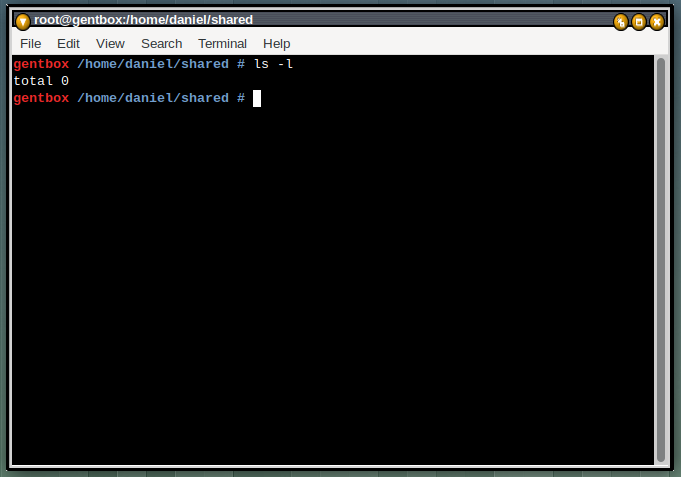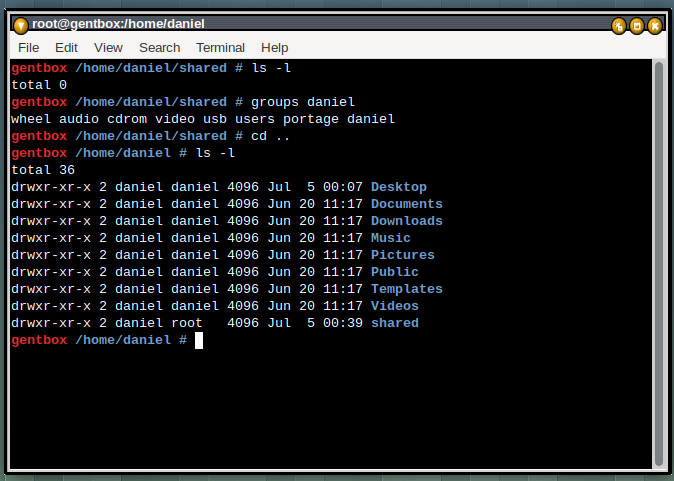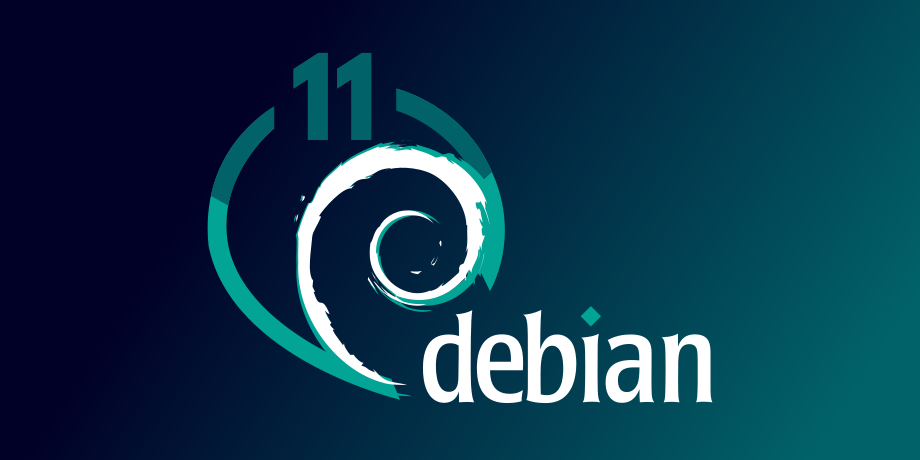
How do I know?

How do I know?
You are still in shared
Go up,to /home/daniel and do ls -l there
Look at /etc/group file
What is that lock symbol in the file manager? Its not already mounted is it?
I do not think it is.

OK shared is owned by daniel, but is in group root
How about
chgrp daniel shared
That should fix it
Then see what the file manager says
@nevj
@Rosika
This post I am about to make has no take-away from the excellent work that the both of you have already accomplished, if you think it does, then I apologize.
The subject hear, for this post, is being able to exchange data from host to guest and or vice-versa, which in most cases, is quite self explanatory, but this has a way of changing between platforms being used and the virtual machine software being used.
First I will do a screenshot with VirtualBox
This mount will last as long as the Virt-Manager QEMU/KVM is running, in other words, if the VM is rebooted, then the above mounted command will have to be issued.
Why is this?
According to the data I have gotten from the internet, is pretty straight forward.
Using virtiofs a shared folder can indeed be entered into /etc/fstab, but if you try to save the state of the VM, like in VB, you will get a migration warning.
When one saves a VM, it will be migrated into ram, and virtiofs, as of now has no working way of migrating the VM.
Does this make VB any better than QEMU/KVM, NO, but it does lead one to the ? of which software is best suited for the user. In my case, since I run Windows, then I will almost always chose VirtualBox.
BTW I am running quickgui, qemu/kvm and VB on the Ubuntu 22.04 platform, so no Windows have been involved.
Except for guickgui this about covers my research, quickgui will come later.
Daniel, that is a great explanation, thank you.
It would seem that , if one wants a permanent mount in Virt-manager, one has to use
an nfs-mount rather than a virtiofs-mount… unless we could find a way to put that mount statement in a startup script… eg put it in /etc/rc.local. Some distros dont have rc.local.
What @Rosika and I are trying to say in this topic is that with virt- manager it is easier to use
the standard linux network commands for communication, rather than fiddle around with menu settings. With Vbox, however, the way to go seems to be to use the menus.
My thinking also, but if VirtualBox can get the shared folder working, the way it should, then why can’t the dev’s working on virtiofs do the same, what is the great mystery surrounding migration?
Back from Sydney
Ah, you are talking about the philosophy difference between Win and Linux.
Vbox is self contained, it does not need other parts of the OS to make it work
Virt-manager does one thing, like most Linux utilities,… it manages vm’s. It depends on Linux for other things, so the best way to use it is to treat it as one cog in a machine, and to supply the other cogs from Linux. … That is why @Rosika and I looked at the Linux networking apps for use with Vmanager… it needs them to work properly.
Try putting the mount statement in /etc/rc.local. Just edit it and add the mount line to the end. That should work, after a reboot. All rc.local does is execute that mount statement (and anything else that you put in there) every time you boot… that is what you want to happen
The whole idea of a special shared folder is a Windows concept too. Most Linux users would just mount the directory they want to work in directly, not muck around copying stuff in and out of a special shared folder. Win and Lin are like chalk and cheese.
Those devs working on viftiofs and Vmanager will never make it like Vbox…they are Unix people… they expect you to use Vmanager with Unix, not on its own
No!!! I am talking about the working difference between QEMU/KVM and VirtualBox, I could care less about the philosophy.
I have never edited the /etc/rc.local!!! Would this be for the host or guest.
Same thing. The working difference is the result of the philosophy difference
In the guest
You want the mount to happen when the guest boots
If the guest is gentoo, I think it will have an rc.local
NO, in Gentoo with OpenRC it is in /etc/local.d
You just write a script ( saying mount) and stick it in that directory. Look up local.d in Gentoo
But read this
It says you can make a file /etc/rc.local even if it does not exist… at least in Debian
Try it, that is the easiest way
I agree,
it´s been a while since I last used virtualbox, so: sorry, I can´t tell much about it. Back then I never even used a shared folder. ![]()
All that was years ago and after using virtualbox I found out vmware was much more to my liking. But here again: I never used shared folders.
In the meantime I´ve grown accustomed to virt-manager, so it´s a good thing for me (and perhaps others as well) that @nevj also showed some extended interest in the matter. ![]()
That seems to be a good idea. ![]()
Cheers from Rosika ![]()
Do you know how to do startup scripts @Rosika?
My experience only extends to rc.local.
This may help
also

The systemd service rc-local.service always exists, and if rc.local resides and is executable, it is immediately pulled into multi-user.target. While starting the Linux system, we can activate rc.local shell script functionality in systemd. When...
I tried this one on my Debian… it works
 Stephan Wijman's Blog – 3 Dec 21
Stephan Wijman's Blog – 3 Dec 21

With Debian 11 (Bullseye) there is no default rc.local file anymore. But this doesn't mean it has been completely removed. The rc-local service is available but it will need a default config file. Create a file /etc/rc.local with the following...
@nevj
Thanks for the suggestion, but I will just use the mount command when I need a mounted shared folder, when running QEMU/KVM. No telling what I would be mounting, if I was too write a script.
hanks for the suggestion, but I will just use the mount command
I would setup an nfs mount ( instead of a virtiofs mount)
Not difficult, just install nfs in the host and export the shared file
Then you can put the mount in /etc/fstab.
Hi Neville, ![]()
Do you know how to do startup scripts @Rosika?
actually I´ve never had cause to employ startup scripts so far.
Once in the past I was considering it for automatically running redshift:
gtk-redshift -l [...] -t 4200:3500
Yet I dismissed it in the end as I need different hue values on different days. It depends on various circumstances (sun is shining or not / degree of cloudiness etc).
As I have set up fish as my default shell it´s easy to access different variants for the redshif command; so I didn´t need a startup script for that.
That said it should be intersting to try out making a startup script.
My experience only extends to rc.local.
That should be alright with me.
I just looked it up on my host (Linux Lite). It doesn´t have the rc.local file. So according to your link I´d have to ceate it first.
I also looked it up in my Debian VM:
rosika2@debian ~> locate rc.local
/snap/core/13308/etc/rc.local
/snap/core/13308/etc/init.d/rc.local
/snap/core/13308/etc/rc2.d/S03rc.local
/snap/core/13308/etc/rc3.d/S03rc.local
/snap/core/13308/etc/rc4.d/S03rc.local
/snap/core/13308/etc/rc5.d/S03rc.local
/snap/core/13308/lib/systemd/system/rc.local.service
/usr/lib/systemd/system/rc.local.service
Here it is present, but only as part of snap.
The link you provided says:
rc.local is simply a legacy from the System V init system. It is the last script to execute before proceeding to a login screen for the desktop environment or a login prompt at the terminal.
Would
/snap/core/13308/etc/rc.local
also be taken into account by the startup procedure ![]()
I guess not, or am I mistaken?
Thanks a lot.
Cheers from Rosika ![]()
P.S.:
thanks also for the other links
Would
/snap/core/13308/etc/rc.local
also be taken into account by the startup procedure
Hi Rozika,
Not sure.
I have another idea… why not use .bashrc instead of rc.local?
You can put any linux command in .bashrc… so why not do the mount there
I will test it tomorrow.
Regards
Neville
Hi Neville, ![]()
I guess - at least in my case - anything that has to do with snaps should be ignored…
… as I have disabled autostart for the service.
I once needed snap for experimental purposes on Debian but later I disabled it:
sudo systemctl stop snapd.service
sudo systemctl disable snapd.service
sudo systemctl mask snapd.service # to make it reboot-safe
So I guess /snap/core/13308/etc/rc.local shouldn´t be taken into account…
yet I´m not completely sure.
I have another idea… why not use .bashrc instead of rc.local?
O.K., I´ll look into it.
Would this also be an option for me, as I have set the fish shell as my default shell? ![]()
Many greetings from Rosika ![]()
Would this also be an option for me, as I have set the
fishshell as my default shell?
Fish will have a dot file, which runs every time you start a shell. Dont know what it is called.
I just realised there is a problem… .bashrc runs for every shell you start… you dint wznt multiple mounts.
Maybe .profile… it might only run once.
We need some file that only runs at boot time. Ideally rc.local.